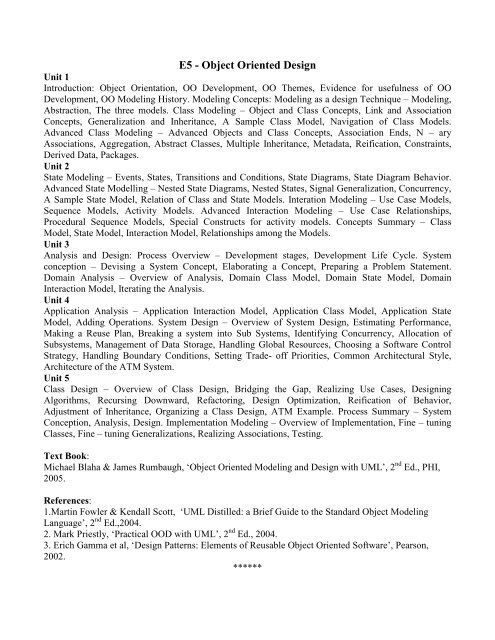course structure - DSpace at CUSAT
course structure - DSpace at CUSAT
course structure - DSpace at CUSAT
You also want an ePaper? Increase the reach of your titles
YUMPU automatically turns print PDFs into web optimized ePapers that Google loves.
E5 - Object Oriented Design<br />
Unit 1<br />
Introduction: Object Orient<strong>at</strong>ion, OO Development, OO Themes, Evidence for usefulness of OO<br />
Development, OO Modeling History. Modeling Concepts: Modeling as a design Technique – Modeling,<br />
Abstraction, The three models. Class Modeling – Object and Class Concepts, Link and Associ<strong>at</strong>ion<br />
Concepts, Generaliz<strong>at</strong>ion and Inheritance, A Sample Class Model, Navig<strong>at</strong>ion of Class Models.<br />
Advanced Class Modeling – Advanced Objects and Class Concepts, Associ<strong>at</strong>ion Ends, N – ary<br />
Associ<strong>at</strong>ions, Aggreg<strong>at</strong>ion, Abstract Classes, Multiple Inheritance, Metad<strong>at</strong>a, Reific<strong>at</strong>ion, Constraints,<br />
Derived D<strong>at</strong>a, Packages.<br />
Unit 2<br />
St<strong>at</strong>e Modeling – Events, St<strong>at</strong>es, Transitions and Conditions, St<strong>at</strong>e Diagrams, St<strong>at</strong>e Diagram Behavior.<br />
Advanced St<strong>at</strong>e Modelling – Nested St<strong>at</strong>e Diagrams, Nested St<strong>at</strong>es, Signal Generaliz<strong>at</strong>ion, Concurrency,<br />
A Sample St<strong>at</strong>e Model, Rel<strong>at</strong>ion of Class and St<strong>at</strong>e Models. Inter<strong>at</strong>ion Modeling – Use Case Models,<br />
Sequence Models, Activity Models. Advanced Interaction Modeling – Use Case Rel<strong>at</strong>ionships,<br />
Procedural Sequence Models, Special Constructs for activity models. Concepts Summary – Class<br />
Model, St<strong>at</strong>e Model, Interaction Model, Rel<strong>at</strong>ionships among the Models.<br />
Unit 3<br />
Analysis and Design: Process Overview – Development stages, Development Life Cycle. System<br />
conception – Devising a System Concept, Elabor<strong>at</strong>ing a Concept, Preparing a Problem St<strong>at</strong>ement.<br />
Domain Analysis – Overview of Analysis, Domain Class Model, Domain St<strong>at</strong>e Model, Domain<br />
Interaction Model, Iter<strong>at</strong>ing the Analysis.<br />
Unit 4<br />
Applic<strong>at</strong>ion Analysis – Applic<strong>at</strong>ion Interaction Model, Applic<strong>at</strong>ion Class Model, Applic<strong>at</strong>ion St<strong>at</strong>e<br />
Model, Adding Oper<strong>at</strong>ions. System Design – Overview of System Design, Estim<strong>at</strong>ing Performance,<br />
Making a Reuse Plan, Breaking a system into Sub Systems, Identifying Concurrency, Alloc<strong>at</strong>ion of<br />
Subsystems, Management of D<strong>at</strong>a Storage, Handling Global Resources, Choosing a Software Control<br />
Str<strong>at</strong>egy, Handling Boundary Conditions, Setting Trade- off Priorities, Common Architectural Style,<br />
Architecture of the ATM System.<br />
Unit 5<br />
Class Design – Overview of Class Design, Bridging the Gap, Realizing Use Cases, Designing<br />
Algorithms, Recursing Downward, Refactoring, Design Optimiz<strong>at</strong>ion, Reific<strong>at</strong>ion of Behavior,<br />
Adjustment of Inheritance, Organizing a Class Design, ATM Example. Process Summary – System<br />
Conception, Analysis, Design. Implement<strong>at</strong>ion Modeling – Overview of Implement<strong>at</strong>ion, Fine – tuning<br />
Classes, Fine – tuning Generaliz<strong>at</strong>ions, Realizing Associ<strong>at</strong>ions, Testing.<br />
Text Book:<br />
Michael Blaha & James Rumbaugh, ‘Object Oriented Modeling and Design with UML’, 2 nd Ed., PHI,<br />
2005.<br />
References:<br />
1.Martin Fowler & Kendall Scott, ‘UML Distilled: a Brief Guide to the Standard Object Modeling<br />
Language’, 2 nd Ed.,2004.<br />
2. Mark Priestly, ‘Practical OOD with UML’, 2 nd Ed., 2004.<br />
3. Erich Gamma et al, ‘Design P<strong>at</strong>terns: Elements of Reusable Object Oriented Software’, Pearson,<br />
2002.<br />
******
















